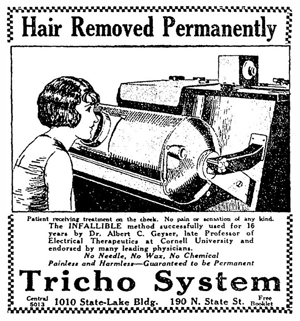 On November 8, 1895, German physicist Wilhelm Röntgen discovered x-ray. The invention was a major scientific breakthrough and the world became fascinated with x-rays. Amazingly, people could now see their bones. X-rays were quickly embraced by physicians and scientists around the world. Physicians began using the machines in their offices. A shoe fitting device using x-rays was patented. There was even a system designed using x-rays to remove excessive hair.
On November 8, 1895, German physicist Wilhelm Röntgen discovered x-ray. The invention was a major scientific breakthrough and the world became fascinated with x-rays. Amazingly, people could now see their bones. X-rays were quickly embraced by physicians and scientists around the world. Physicians began using the machines in their offices. A shoe fitting device using x-rays was patented. There was even a system designed using x-rays to remove excessive hair.
Albert C. Geyser invented the Cornell Tube in 1905. The tube was thought to be a safer form of X-rays. The Cornell tube was an X-ray vacuum tube made of leaded glass with one area of regular glass for shinning an ultra-soft x-ray directly on a small spot of skin. The tube supposedly did not emit extra rays and so it reduced the possibility of being burned by the x-rays.
Geyser used this tube to create the Tricho system. The machine was used to remove unwanted hair from the chin, cheeks and upper lips of women by using direct x-rays. Women sat in front of a cabinet with a window where the x-ray came out. A switch turned on the machine though it seemed like nothing happened besides a slight hum. The machine then switched off automatically.
Over 75 salons in the Untied States had Tricho machines in 1925. Women paid between a couple hundred and a few thousand dollars for treatments. Generally complete hair removal was achieved with about 20 sessions each lasting only a few minutes.
Today, we know that x-rays are not safe but unfortunately the damaging effects of Tricho machine were not immediately evident. One of the first complaints came from Ida Thomas. In 1926, she sued Albert’s son, Frank Geyser, for $100,739 – the cost of treatment plus $100,000. Ida Thomas noted that Frank cured her of her facial hair problems in 1924, but her skin wrinkled and thickened. Soon, after doctors began seeing many cases of burnt, scarred and wrinkled skin.
Despite Frank Geyser’s insistence that the Tricho machine was safe, more lawsuits and arrests came to operators of the systems. Eventually in 1930, after being sued for millions of dollars the Tricho Machine Company dissolved.
